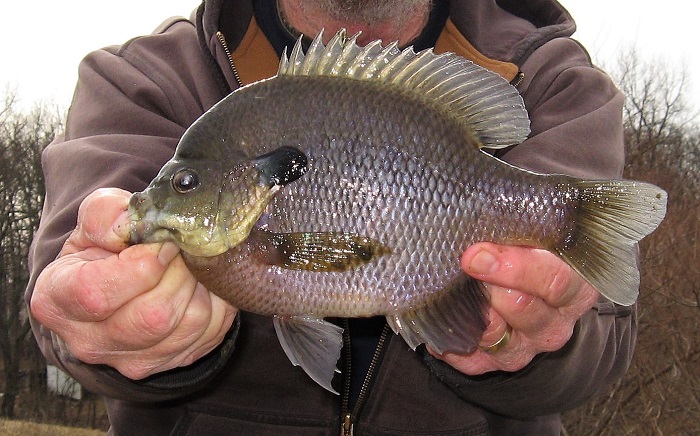
Maryland's Late Winter Panfish
Even though the groundhog said we have six week of winter left, here in Maryland you don’t have to wait for the spring to make your catch. Maryland’s lakes and ponds throughout the state are full of winter panfish opportunities if you know where to look and the proper gear to use. Not only is it a great way to spend a weekend with the family, but panfishing is also a great way to keep your angling skills sharp during the winter. Though this article focuses primarily on in Central Maryland, where I spend most of my time fishing, the same principles apply to all freshwater lakes and ponds across the state.
[gallery link="none" columns="2" size="medium" ids="5137,5140"]
Long before the skim-ice is completely gone from our waters, various panfish species are feeding and starting to actually move into shallow, sun-warmed coves, offering angler’s a long-awaited reboot from the previous fishing season. Hungry from the winter’s lack of aquatic abundance and lower water temperatures, bluegills, crappies, and yellow perch will be making movements to the shallows and are vulnerable to sensitive, light-tackle presentations. Though many of our regional parks and lakes are not yet open for boating, however, now is the time for the panfishing “foot soldier” to cash in on a wintertime bounty.
Success for late winter panfish revolves around timing and tackle. Most of my quality trips during the past 20 winters were during stable to warming weather conditions where west to southerly prevailing winds dominated for a few days, pushing sun-warmed surface water into leeward shorelines and coves where a thermal bank of warm water attracted lethargic panfish. These areas can be as much as five degrees warmer than the rest of the lake or pond, but it is enough to draw hungry bluegills and crappies as they seek wind-blown and emerging food items like midge larvae, grass shrimp and zoo-plankton. Various minnow species and tidal mummichogs are also attracted to these areas bringing larger game – such as largemouth bass and big crappies – following in quest of a bigger meal. This food-chain buffet will subside when colder, harsher conditions cause the thermal bank, and fish species, to disperse until the next round of moderate to warming conditions occur.

During this time, we have found that ultra-light spinning gear, tiny “micro-jigs,” and fine lines rule the winter panfish game. Rod lengths can vary, but 6.5- to 7.5-foot light spinning sticks cover most of the bases. Teamed with small ultra-light reels spooled with quality 4-pound test monofilament line, they enable the delivery of jigs up to 1/16th of an ounce. Since the majority of these bluegills and crappies will be suspended in the water column, a sensitive float or foam bobber allows both casting distance and proper lure travel once the depth of the fish are located. Traditionally, we find them in 4- to 7-feet of water, so some experimentation is usually required to locate the exact depth of pods of panfish.
[gallery link="none" columns="2" size="medium" ids="5138,5142"]
Occasionally, we will drop down to 2-pound test monofilament for very sensitive bites from zombie-like bluegills that are just now emerging from their deeper, winter haunts. For this reason, the lightest, most sensitive floats that will barely suspend a jig and move with the slightest nibble are needed in order to detect a strike. Often, the float does not go under, but merely “trails off” in another direction or tips on its side.
If your target is bluegills, then think smaller than small for jig size. We have had the most success with both plain jigs and hair jigs of 1/80th of an ounce. Additionally, we tip these lures with any variety of live baits such as meal worms, wax worms or larvae (maggots) for added appeal. For crappie, we like 1/32nd and 1/16th ounce jigs. Tip those offerings with the same baits or else use Berkley Gulp! 1-inch Minnows. A variety of plastic twisters, tubes or smaller 1.5-inch shad bodies will also attract them. You can fish these with slightly larger floats or cast and retrieve them without.

Central Maryland is blessed with numerous public and private waters that are capable of producing quality panfish catches long before the late spring spawning periods when fish are on their beds. We tend to harvest bluegills in the 7- to 8 ½-inch range and crappies from 10 to 12 inches in length. Every body of water is different, but all offer a fishing opportunities now that you know what you need for winter panfishing in Maryland.

Whether you’re coming from another part of Maryland, or out of state, getting to Central Maryland (made up of Carroll, Baltimore, Harford, Howard, and Anne Arundel Counties) is an easy drive with a ton of fishing opportunities. Click here for help in finding resources to plan a trip today.
Here are a few public venues that are good starting points for mid-winter panfishing:
- PINEY RUN RESEVOIR, near Eldersburg, Maryland in Carroll County, features a 290-acre body of water located within Piney Run Park with walk-in options for winter crappies and bluegills. Call (410) 795-5165 for information.
- CUNNINGHAM FALLS STATE PARK, near Thurmont, Maryland in Frederick County, you’ll find 46-acre Cunningham Falls Lake with has crappies, bluegills, and big red-eared sunfish. Call (301) 271-7574 for information.
- CENTENNIAL LAKE, in northern Howard County, offers a 40-acre lake with bluegills, crappies, and big pumpkinseed sunfish featuring a walking path around the entire lake. Call (410) 313-7271 for information.
- NUMEROUS PARK LAKES throughout central and south-central Maryland. Consult the 2018 Maryland Guide to Fishing & Crabbing for contact information, regulations, and locations.
This post was written by Jim Gronaw
Images courtesy of the author